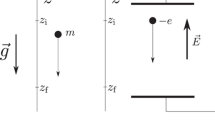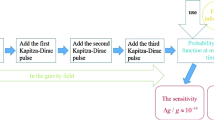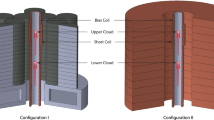Abstract
We propose a technique using an atom interferometer to obtain the most accurate measurement of gravitational acceleration by changing the interaction time between the atoms and gravity in a harmonic trap. The analytical calculation procedure is based on the Feynman path integral method. The first Kapitza–Dirac (KD) scattering pulse splits the initial state into several modes with different momenta. Before adding the second KD pulse, the interaction time between the atoms and gravity is changed. These modes have a position shift as a result of the gravitational field and are coherently recombined by the harmonic potential. The second KD pulse splits the evolved modes a second time and separates them along different paths again. At the measurement time, we obtain the greatest accuracy from the quantum Fisher information. For the variation of gravitational acceleration on the surface of earth, an accuracy of \(10^{-9}\) can be achieved at any value of gravity acceleration by tuning the interaction time between the atoms and gravity.



Similar content being viewed by others
References
P Asenbaum, C Overstreet, T Kovachy, D D Brown, J M Hogan and M A Kasevich, Phys. Rev. Lett. 118 183602 (2017)
G W Biedermann et al. Phys. Rev. Lett. 118 163601 (2017)
S Abend et al. Phys. Rev. Lett. 117 203003 (2016)
R Trubko et al. Phys. Rev. Lett. 114 140404 (2015)
A D Cronin, J Schmiedmayer and D E Pritchard Rev. Rev. Mod. Phys. 81 1051 (2009)
D W Keith, C R Ekstrom, Q A Turchette and D E Pritchard Phys. Phys. Rev. Lett. 66 2693 (1991)
E M Rasel, M K Oberthaler, H Batelaan, J Schmiedmayer and A Zeilinger Phys. Phys. Rev. Lett. 75 2633 (1995)
D M Giltner, R W McGowan and S A Lee Phys. Phys. Rev. Lett. 75 2638 (1995)
H Vahed and Sh Aghazadeh Indian J. Phys. 91(5) 569 (2017)
T Farah et al. Gyroscopy Navigation 5 266 (2014)
A Wicht, J Hensley, E Sarajlic and S Chu Phys. Phys. Scr. T102 82 (2002)
G Rosi, F Sorrentino, L Cacciapuoti, M Prevedelli and G M Tino Nature 510 518 (2014)
M A Kasevich and S Chu Phys. Rev. Lett. 67 181 (1991)
J M McGuirk, G T Foster, J B Fixler, M J Snadden and M A Kasevich Phys. Rev. A 65 033608 (2002)
J B Fixler, G T Foster, J M McGuirk and M A Kasevich Science 315 74 (2007)
R A Fisher Proc. Cambridge Philos. Soc. 22 700 (1925)
A Holevo Probabilistic and Statistical Aspects of Quantum Theory (Italy: Edizioni della Normale) (1982)
Y Watanabe, T Sagawa and M Ueda Phys. Rev. A 84 042121 (2011)
A Peters, K Y Chung and S Chu Nature 400 849 (1999)
N Li and S Luo Phys. Rev. A 88 014301 (2013)
C Keller, J Schmiedmayer, A Zeilinger, T Nonn, S Dürr and G Rempe Appl. Phys. B 69 303 (1999)
L Melville Milne-Thomson Handbook of Mathematical Functions With Formulas, Graphs and Mathematical Tables (New York: Dover Publications) (1964)
B R Holstein Topics in advanced quantum mechanics (New York: Perseus Books) (1994)
C Hirt, S Claessens, T Fecher, M Kuhn, R Pail and M Rexer Geophysical Research Letters. 40 4279 (2013)
R E Sapiro, R Zhang and G Raithel Phys. Rev. A 79 043630 (2009)
Acknowledgements
This work was supported by the National Natural Science Foundation of China (Grant No. 11647041)
Author information
Authors and Affiliations
Corresponding author
Rights and permissions
About this article
Cite this article
He, T., Wang, EQ. Maximizing gravitational acceleration measurement accuracy by tuning the interaction time between atoms and gravity. Indian J Phys 92, 1223–1228 (2018). https://doi.org/10.1007/s12648-018-1222-4
Received:
Accepted:
Published:
Issue Date:
DOI: https://doi.org/10.1007/s12648-018-1222-4




